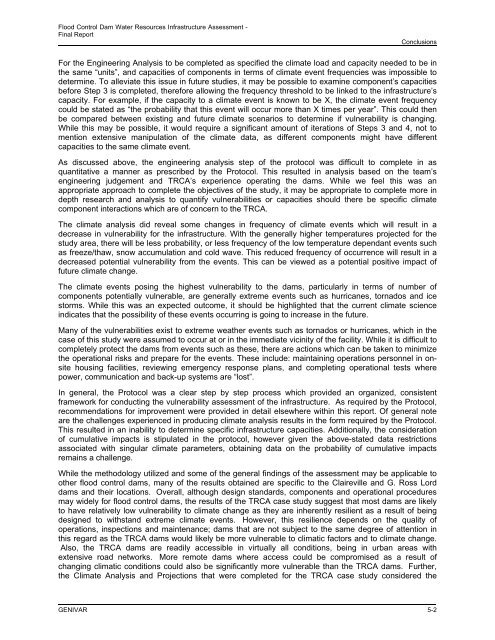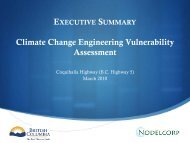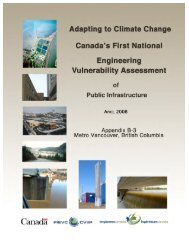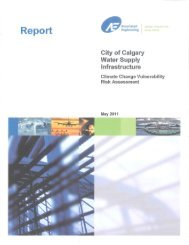Final Report - Vulnerability Committee
Final Report - Vulnerability Committee
Final Report - Vulnerability Committee
Create successful ePaper yourself
Turn your PDF publications into a flip-book with our unique Google optimized e-Paper software.
Flood Control Dam Water Resources Infrastructure Assessment -<strong>Final</strong> <strong>Report</strong>ConclusionsFor the Engineering Analysis to be completed as specified the climate load and capacity needed to be inthe same “units”, and capacities of components in terms of climate event frequencies was impossible todetermine. To alleviate this issue in future studies, it may be possible to examine component’s capacitiesbefore Step 3 is completed, therefore allowing the frequency threshold to be linked to the infrastructure’scapacity. For example, if the capacity to a climate event is known to be X, the climate event frequencycould be stated as “the probability that this event will occur more than X times per year”. This could thenbe compared between existing and future climate scenarios to determine if vulnerability is changing.While this may be possible, it would require a significant amount of iterations of Steps 3 and 4, not tomention extensive manipulation of the climate data, as different components might have differentcapacities to the same climate event.As discussed above, the engineering analysis step of the protocol was difficult to complete in asquantitative a manner as prescribed by the Protocol. This resulted in analysis based on the team’sengineering judgement and TRCA’s experience operating the dams. While we feel this was anappropriate approach to complete the objectives of the study, it may be appropriate to complete more indepth research and analysis to quantify vulnerabilities or capacities should there be specific climatecomponent interactions which are of concern to the TRCA.The climate analysis did reveal some changes in frequency of climate events which will result in adecrease in vulnerability for the infrastructure. With the generally higher temperatures projected for thestudy area, there will be less probability, or less frequency of the low temperature dependant events suchas freeze/thaw, snow accumulation and cold wave. This reduced frequency of occurrence will result in adecreased potential vulnerability from the events. This can be viewed as a potential positive impact offuture climate change.The climate events posing the highest vulnerability to the dams, particularly in terms of number ofcomponents potentially vulnerable, are generally extreme events such as hurricanes, tornados and icestorms. While this was an expected outcome, it should be highlighted that the current climate scienceindicates that the possibility of these events occurring is going to increase in the future.Many of the vulnerabilities exist to extreme weather events such as tornados or hurricanes, which in thecase of this study were assumed to occur at or in the immediate vicinity of the facility. While it is difficult tocompletely protect the dams from events such as these, there are actions which can be taken to minimizethe operational risks and prepare for the events. These include: maintaining operations personnel in onsitehousing facilities, reviewing emergency response plans, and completing operational tests wherepower, communication and back-up systems are “lost”.In general, the Protocol was a clear step by step process which provided an organized, consistentframework for conducting the vulnerability assessment of the infrastructure. As required by the Protocol,recommendations for improvement were provided in detail elsewhere within this report. Of general noteare the challenges experienced in producing climate analysis results in the form required by the Protocol.This resulted in an inability to determine specific infrastructure capacities. Additionally, the considerationof cumulative impacts is stipulated in the protocol, however given the above-stated data restrictionsassociated with singular climate parameters, obtaining data on the probability of cumulative impactsremains a challenge.While the methodology utilized and some of the general findings of the assessment may be applicable toother flood control dams, many of the results obtained are specific to the Claireville and G. Ross Lorddams and their locations. Overall, although design standards, components and operational proceduresmay widely for flood control dams, the results of the TRCA case study suggest that most dams are likelyto have relatively low vulnerability to climate change as they are inherently resilient as a result of beingdesigned to withstand extreme climate events. However, this resilience depends on the quality ofoperations, inspections and maintenance; dams that are not subject to the same degree of attention inthis regard as the TRCA dams would likely be more vulnerable to climatic factors and to climate change.Also, the TRCA dams are readily accessible in virtually all conditions, being in urban areas withextensive road networks. More remote dams where access could be compromised as a result ofchanging climatic conditions could also be significantly more vulnerable than the TRCA dams. Further,the Climate Analysis and Projections that were completed for the TRCA case study considered theGENIVAR 5-2








